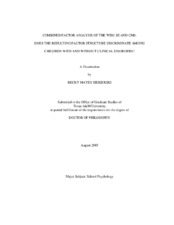| dc.description.abstract | The Wechsler Intelligence Scale for Children – Third Edition (WISC-III;
Wechsler, 1991) and the Children’s Memory Scale (CMS; Cohen, 1997) are frequently
used measures of children’s cognitive ability and memory, respectively. They are often
used together to assess a child’s strengths and weaknesses to individualize
recommendations for assisting them in the educational setting. However, research
suggests that there may be some overlap in the abilities assessed by these instruments,
making complete administration of both somewhat redundant. Furthermore, previous
studies have been equivocal with regard to the assessment of children with Attention-
Deficit/ Hyperactivity Disorder (ADHD) on the WISC-III. Support for the applicability
of the four-factor structure of the WISC-III has been questioned, particularly in terms of
its utility in the diagnosis of ADHD based on the Freedom from Distractibility Index
(FFD). A combined confirmatory factor analysis was conducted on the WISC-III and
CMS to determine whether a combination of their subtests could be used in lieu of
complete administration of each test. The combined WISC-III/ CMS standardization sample was obtained from the
Psychological Corporation for use in the confirmatory factor analyses. One-, six-, and
seven-factor models were initially proposed for the analyses. Results of the combined
confirmatory factor analyses indicated that all three models failed to fit the data as well
as a new five-factor model that was created during modification of the six-factor model.
Once the five-factor model was specified as the most appropriate model, a
clinical sample from a research study was analyzed on the model to find out whether
there were age and gender performance differences and also to determine how accurately
the new factors differentiated between clinical and nonclinical subsamples. Results
indicated that males and females performed significantly differently on the Processing
Speed factor but there were no age differences. There were significant differences
between the ADHD and no diagnosis groups on three factors: Verbal Comprehension,
Working Memory, and Processing Speed; there were no differences on the factors
between ADHD subtypes. Together, the five factors were able to correctly classify 66%
of children with ADHD. Implications of these results are discussed and suggestions for
future research are provided. | en |


